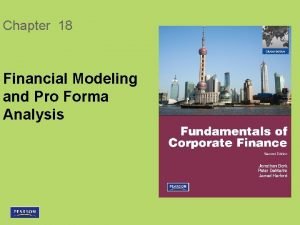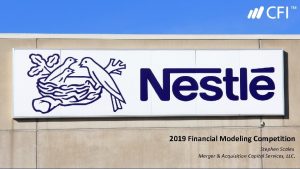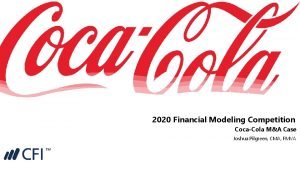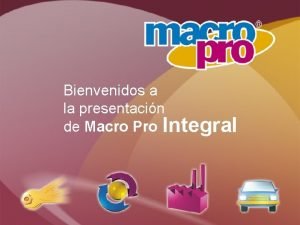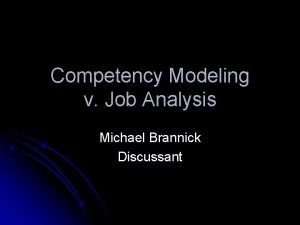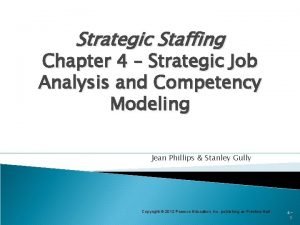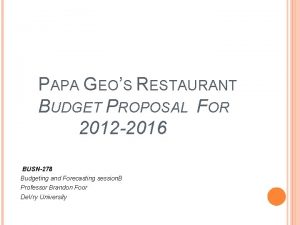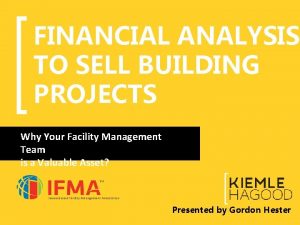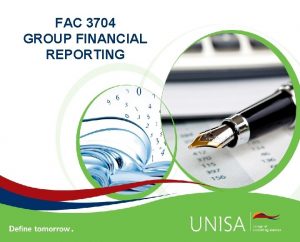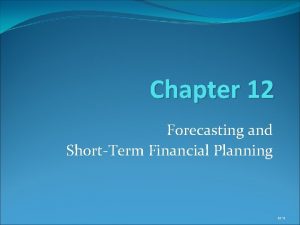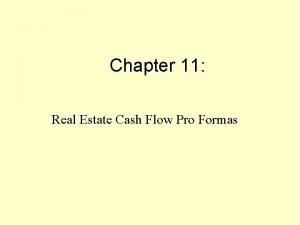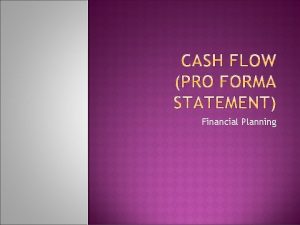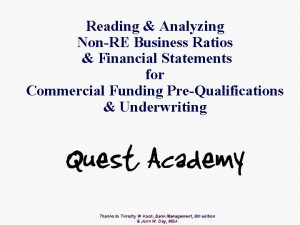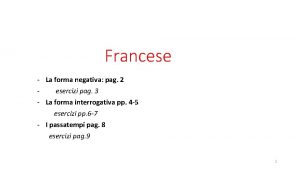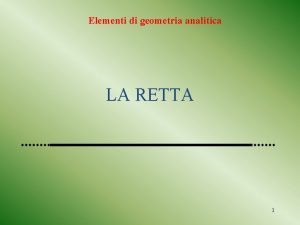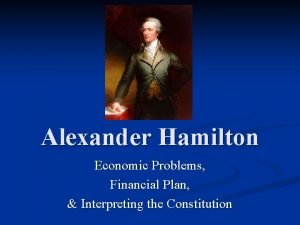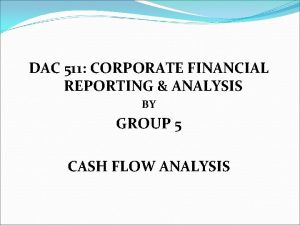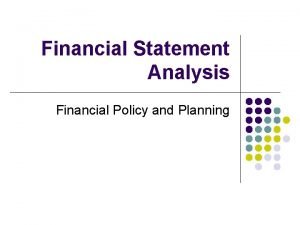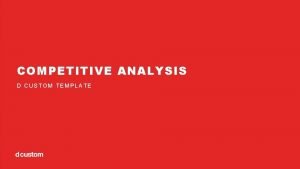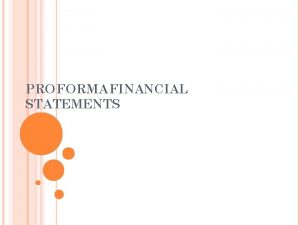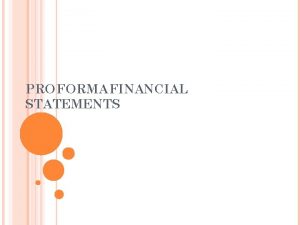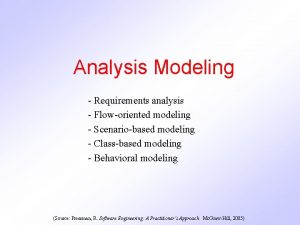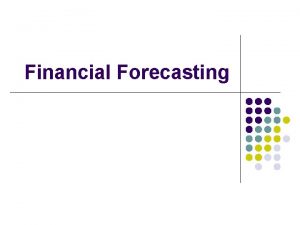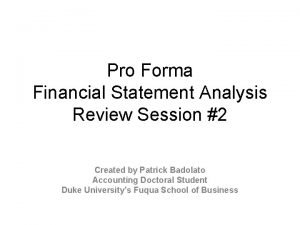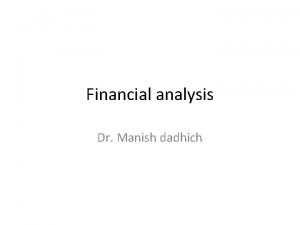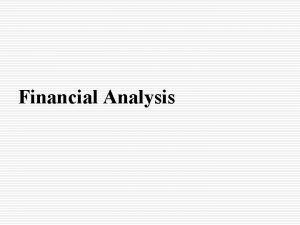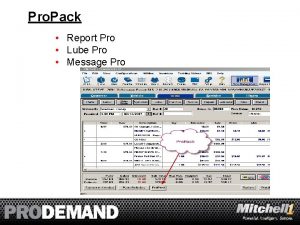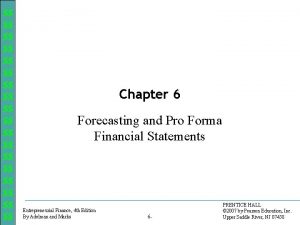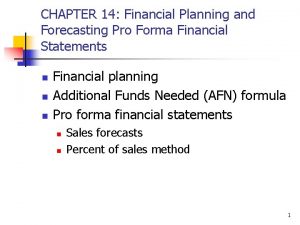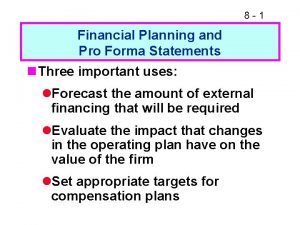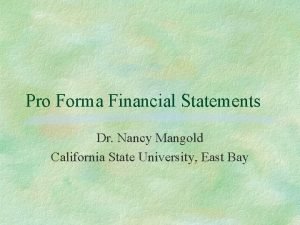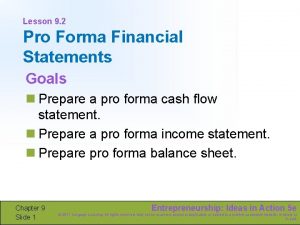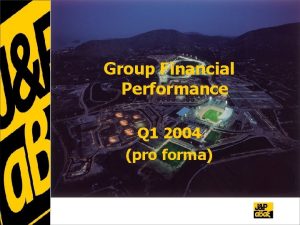Financial Modeling and Pro Forma Analysis Outline of













































- Slides: 45

Financial Modeling and Pro Forma Analysis

Outline of the Topics Goals of Long-Term Financial Planning Forecasting Financial Statements: The Percent of Sales Method Forecasting a Planned Expansion Growth and Firm Value Valuing the Expansion

Learning Objectives • Understand the goals of long-term financial planning • Create pro forma income statements and balance sheets using the percent of sales method • Develop financial models of the firm by directly forecasting capital expenditures, working capital needs, and financing events • Distinguish between the concepts of sustainable growth and value-increasing growth • Use pro-forma analysis to model the value of the firm under different scenarios, such as expansion

1 Goals of Long-Term Financial Planning • Identify Important Linkages • Sales, costs, capital investment, financing, etc. • Analyze the Impact of Potential Business Plans • Plan for Future Funding Needs

2 Forecasting Financial Statements: The Percent of Sales Method • A forecasting method that assumes that balance sheet and income statement items grow proportionately with sales • Percent of sales remains constant in future periods • Forecasts of balance sheet and income statement items are made as a percent of the expected sales figure for that period

KMS Designs 2016 Income Statement and Balance Sheet Table 1 KMS Designs 2016 Income Statement and Balance Sheet

Forecasting Financial Statements: The Percent of Sales Method • Pro Forma Income Statement • KMS Designs forecasts 18% growth in sales from 2016 to 2017 • In 2016: • Costs excluding depreciation were 78% of sales • Depreciation was 7. 333% of sales • Tax rate = 3, 737 / 10, 678 = 35% • For now, assume interest expense remains the same as 2016

KMS Designs’ Pro Forma Income Statement for 2017 Table 2 KMS Designs’ Pro Forma Income Statement for 2017

Example-1 Percent of Sales Problem • KMS has just revised its sales forecast downward. If KMS expects sales to grow by only 10% next year, what are its costs, except for depreciation, projected to be? • Answer: • Forecasted 2017 sales will now be: $74, 889 × (1. 10) = $82, 378. • With this figure in hand the information from Table 1, we can use the percent of sales method to calculate KMS’s forecasted costs. • From Table -1, we see that costs are 78% of sales. • With forecasted sales of $82, 378, that leads to forecasted costs except depreciation of $82, 378 × (0. 78) = $64, 255.

Forecasting Financial Statements: The Percent of Sales Method • Pro Forma Balance Sheet • Make assumptions about how equity and debt will grow with sales • The difference between Assets and Liabilities + Equity indicates the net new financing to fund growth

First-Pass Pro Forma Balance Sheet for 2017 Table -3 First-Pass Pro Forma Balance Sheet for 2017

Forecasting Financial Statements: The Percent of Sales Method • Making the Balance Sheet Balance: Net New Financing • Management must choose new funding • Debt or equity. • Complex issues involved are discussed in the capital structure and dividend policy of the firm. • If debt is chosen, it will change the interest assumption on the pro forma income statement.

Second-Pass Pro Forma Balance Sheet for KMS Table -4 Second-Pass Pro Forma Balance Sheet for KMS

Example -2 Dividend Policy and Net New Financing Problem • If instead of paying out 30% of earnings as dividends, KMS decides not to pay any dividend and instead retains all of its 2016 earnings, how would its net new financing change? • Answer: • KMS currently pays out 30% of its net income as dividends, so rather than retaining only $5758, it will retain the entire $8226. This will increase stockholders’ equity, reducing the net new financing.

Example -2 Dividend Policy and Net New Financing Analysis • The additional retained earnings are $8226 − $5758 = $2468. • Compared to Table-3, stockholders’ equity will be $79, 892 + $2468 = $82, 360 and total liabilities and equity will also be $2468 higher, rising to $100, 999. • Net new financing, the imbalance between KMS’s assets and liabilities and equity, will decrease to $8396 − $2468 = $5928.

Example-2 Dividend Policy and Net New Financing Evaluation • When a company is growing faster than it can finance internally, any distributions to shareholders will cause it to seek greater additional financing. It is important not to confuse the need for external financing with poor performance. • Most growing firms need additional financing to fuel that growth as their expenditures for growth naturally precede their income from that growth. We will revisit the issue of growth and firm value in future Section

Forecasting Financial Statements: The Percent of Sales Method • Choosing a Forecast Target • Target specific ratios that the company wants or needs to maintain. • Debt covenants to maintain liquidity or interest coverage • Investment, payout, and financing decisions are linked together • Financial managers must balance these decisions • Careful forecasting helps see consequences

Forecasting a Planned Expansion • Percent of sales method ignores real-world “lumpy” investments in capacity. • Can’t buy half of a factory, or add retail space by the square foot. • Added in one lump investment in new Property, Plant and Equipment. • Firms often make large investments that will provide capacity for several years.

Forecasting a Planned Expansion • Analyzing the effect of a planned expansion on firm value: • Identify capacity needs and financing options • Construct pro forma income statements and forecast future cash flows • Use forecasted free cash flows to assess the impact of expansion

KMS’s Forecasted Production Capacity Requirements Table -5 KMS’s Forecasted Production Capacity Requirements

Forecasting a Planned Expansion • Capital Expenditures for the Expansion • New PP&E = $20 million , must be purchased in 2017 to meet minimum capacity requirements • KMS must invest $5 million in 2016 and 2017 to replace depreciated equipment • After expansion, KMS must invest $8 million per year for depreciation 2018 -2021 Table -6 KMS’s Forecasted Capital Expenditures

Forecasting a Planned Expansion KMS’s Planned Debt and Interest Payments • KMS will fund recurring investment from operating cash flows • KMS will finance the new equipment by issuing 10 -year coupon bonds with a coupon rate of 6. 8%. Interest in Year t = Interest Rate × Ending balance in year (t − 1) Table -7 KMS’s Planned Debt and Interest Payments

Forecasting a Planned Expansion • KMS Designs’ Expansion: Pro Forma Income Statement • Value of new investment opportunity comes from future cash flows from investment • Estimate cash flows: 1. Project future earnings 2. Consider working capital and investment needs and estimate free cash flow 3. Compute value of company with/without expansion.

Forecasting a Planned Expansion • Forecasting Earnings Sales = Market Size × Market Share × Average Sales Price Table-8 Pro Forma Income Statement for KMS Expansion

Forecasting a Planned Expansion • Working Capital Requirements • Increases in working capital reduce free cash flow • KMS Example: • We assume minimum cash requirements will remain 16% of sales, A/R = 19% of sales, Inventory = 20% of sales, A/P = 16% of sales as in 2016 • *Excess cash is distributed as dividends.

KMS Projected Working Capital Needs Table-9 KMS Projected Working Capital Needs

Forecasting a Planned Expansion • Forecasting the Balance Sheet • When we forecast L + E > A, excess cash is available • Options: • • Build extra cash reserves Retire debt Distribute excess as dividends Repurchase shares • When L + E < A, additional financing is needed

Pro Forma Balance Sheet for KMS, 2017 Table -10 Pro Forma Balance Sheet for KMS, 2017 Year Balance Sheet (000 s) Asset Cash and Cash Equivalents Account Receivable Inventories Total Current Assets Property, Plant and Equipment Total Assets Liabilities Accounts Payable Debt Total Liabilities Stockholders' Equity Starting Stockholder's Equity Net Income Dividends Stockholders' Equity Total Liabilities and Equity 2016 2017 Source for 2017 Data 2017 Revised $14, 139 $16, 790 $17, 674 $48, 603 $66, 984 $115, 587 $11, 982 $14, 229 $14, 978 $41, 189 $49, 427 $90, 616 $14, 139 $16, 790 $17, 674 $48, 603 $66, 984 $115, 587 Table 9 $11, 982 $4, 500 $16, 482 $14, 139 $24, 500 $38, 639 Table 7 $69, 275 $6, 941 -$2, 080 $74, 136 $90, 618 $74, 134 $7, 600 $0 $81, 734 $120, 373 Table 6 Table 8 $14, 139 $24, 500 $38, 639 $74, 134 $7, 600 -$4, 786 $76, 948 $115, 587

Pro Forma Balance Sheets and Financing Table-11 Pro Forma Balance Sheets and Financing Liabilities and equity are. . Less than assets. Blank New financing is needed— the firm must reduce dividends, borrow, or issue new equity to fund the shortfall. Greater than assets Excess cash is available— the firm can retain it as extra cash reserves (thus increasing assets), pay dividends, or reduce external financing by retiring debt or repurchasing shares.

4 Growth and Firm Value • Not all growth is worth the price • It is possible to pay so much for the growth that the firm value declines • Other aspects of growth can leave the firm less valuable: • May strain managers’ ability to monitor • May surpass the firm’s distribution capabilities, quality control or change perceptions of the firm and its brand

4 Growth and Firm Value • Sustainable Growth Rate Versus Internal Growth Rate • ROE will be larger than your ROA any time you have debt, thus the sustainable growth rate will be greater than the internal growth rate • While the internal growth rate assumes no external financing, the sustainable growth rate assumes you will make use of some outside financing equal to the amount of new debt that will keep your debt-to-equity ratio constant as your equity grows through reinvested net income

4 Growth and Firm Value (Eq. 18. 4) (Eq. 18. 5)

Example-3 Internal and Sustainable Growth Rates and Payout Policy Problem: • Your firm has $70 million in equity and $30 million in debt and forecasts $14 million in net income for the year. • It currently pays dividends equal to 20% of its net income. You are analyzing a potential change in payout policy—an increase in dividends to 30% of net income. • How would this change affect your internal and sustainable growth rates?

Example-3 Internal and Sustainable Growth Rates and Payout Policy Solution: Plan: • We can use sustainable and internal equations to compute your firm’s internal and sustainable growth rates under the old and new policy. • To do so, we’ll need to compute its ROA, ROE, and retention rate (plowback ratio). • The company has $100 million 1 = $70 million in equity + $30 million in debt 2 in total assets.

Example-3 Internal and Sustainable Growth Rates and Payout Policy Old Internal Growth Rate = ROA × Retention Rate = 14% × 0. 80 = 11. 2% New Internal Growth Rate = 14% × 0. 70 = 9. 8%

Example-3 Internal and Sustainable Growth Rates and Payout Policy • Similarly, we can compute the sustainable growth rate before and after: Old Sustainable Growth Rate = ROE × Retention Rate = 20% × 0. 80 = 16% New Sustainable Growth Rate = 20% × 0. 70 = 14% By reducing the amount of retained earnings available to fund growth, an increase in the payout ratio necessarily reduces your firm’s internal and sustainable growth rates.

Table-12 Summary of Internal Growth Rate Versus Sustainable Growth Rate Blank Internal Growth Rate Sustainable Growth Rate Formula: ROA * Retention Rate ROE * Retention Rate Maximum growth financed only by: Retained earnings and new debt that keeps D/E ratio constant To grow faster, a firm Reduce payout or raise must: external capital Reduce payout, raise new equity, or increase leverage

4 Growth and Firm Value • Internal and sustainable growth rates are useful but they cannot tell you whether your planned growth increases or decreases the firm’s value • They do not evaluate future costs and benefits of the growth • Growth greater than sustainable growth rate is not bad as long as it is value increasing • Your firm will need to raise additional capital to finance the growth

5 Valuing the Expansion • Forecasting Free Cash Flows • Calculate the net present value of the increase in cash flows generated by the investment • First, we calculate forecasted free cash flows • Start with Net Income • Add additional tax shield from interest expense • Add back depreciation (not a cash expense) • Subtract changes in NWC and capital expenditures

KMS Forecasted Free Cash Flow Table-13 KMS Forecasted Free Cash Flow

5 Valuing the Expansion • KMS Designs’ Expansion: Effect on Firm Value • Absent distress costs, the value of a firm with debt is equal to the value of the firm without debt plus the present value of its interest tax shields • Apply the same approach to valuing the expansion: • Compute the present value of the unlevered free cash flows • Add to it the present value of the tax shields created by planned interest payments • Need to compute a continuation value

5 Valuing the Expansion • Multiples Approach to Continuation Value • EBITDA multiple is most often used in practice • Accounts for the firm’s operating efficiency • Not affected by leverage differences between firms Continuation Enterprise Value at Forecast Horizon = EBITDA at Horizon × EBITDA Multiple at Horizon

5 Valuing the Expansion (4 of 6) • KMS Designs’ value with the Expansion • KMS’ estimated unlevered cost of capital is 10% (specifically, 10% is their pretax WACC) Table-14 Calculation of KMS Firm Value with the Expansion

18. 5 Valuing the Expansion (5 of 6) • KMS Designs’ value without the Expansion • Without the expansion, KMS will be limited to its capacity of 1, 100 units Table-15 Sales Forecast Without Expansion

KMS’ Value Without the Expansion • Firm value is almost $60 million less without the expansion Table -16 KMS’ Value Without the Expansion
 Pro forma income statement
Pro forma income statement Modeling role modeling theory
Modeling role modeling theory Dimensional modeling vs relational modeling
Dimensional modeling vs relational modeling Merger and acquisition financial modeling
Merger and acquisition financial modeling Example of topic outline and sentence outline
Example of topic outline and sentence outline Financial modeling competition
Financial modeling competition Macro pro
Macro pro Simulation kelton
Simulation kelton Dfd ch5
Dfd ch5 Requirements modeling in system analysis and design
Requirements modeling in system analysis and design Job analysis and competency modeling
Job analysis and competency modeling Manufacturing systems modeling and analysis
Manufacturing systems modeling and analysis Job analysis in staffing
Job analysis in staffing Revenues minus expenses equals
Revenues minus expenses equals Papa geos
Papa geos Pro forma noi
Pro forma noi Pro-forma entry
Pro-forma entry Pro forma income statement
Pro forma income statement Real estate investment pro forma
Real estate investment pro forma Project implementation cost
Project implementation cost Plug figure in pro forma projections
Plug figure in pro forma projections Financial motivators
Financial motivators Frasi passiva
Frasi passiva Frasi dalla forma attiva alla forma passiva
Frasi dalla forma attiva alla forma passiva Da forma algebrica a forma trigonometrica
Da forma algebrica a forma trigonometrica Esercizi forma negativa francese pdf
Esercizi forma negativa francese pdf Pronomi personali soggetto complemento e riflessivi
Pronomi personali soggetto complemento e riflessivi Elementi di geometria analitica
Elementi di geometria analitica Indicati adjectivele si substantivele determinate
Indicati adjectivele si substantivele determinate Hamilton's financial plan drawing
Hamilton's financial plan drawing Describe data and process modeling concepts and tools
Describe data and process modeling concepts and tools Linear quadratic function
Linear quadratic function Typical process description tools include
Typical process description tools include Financial statements and ratio analysis chapter 3
Financial statements and ratio analysis chapter 3 How to improve current ratio
How to improve current ratio Financial analysis planning and forecasting
Financial analysis planning and forecasting Corporate financial reporting and analysis
Corporate financial reporting and analysis Financial statement analysis and planning
Financial statement analysis and planning Financial statement of commercial bank
Financial statement of commercial bank Cultural domain definition
Cultural domain definition Ad analysis outline
Ad analysis outline Industry analysis outline
Industry analysis outline Competitive analysis outline
Competitive analysis outline How to write a poem analysis essay
How to write a poem analysis essay Competitive analysis doc
Competitive analysis doc Sequential decision analytics
Sequential decision analytics
